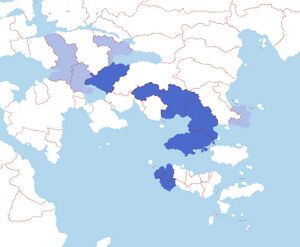Pan-Dolchism: Difference between revisions
No edit summary |
No edit summary |
||
| (2 intermediate revisions by 2 users not shown) | |||
| Line 1: | Line 1: | ||
'''Pan-Dolchism''' ({{wp|German Language|Dolch}}: ''Pandolchismus'' or ''Alldolch Bewegung''), ({{wp|Volapük Language|Stedorian}}: '' | '''Pan-Dolchism''' ({{wp|German Language|Dolch}}: ''Pandolchismus'' or ''Alldolch Bewegung''), ({{wp|Volapük Language|Stedorian}}: ''Valadolcim'' or ''Muf Valadolcik''), also known as '''Pan-Dolchicism''', is a {{wp|pan-nationalism|pan-nationalist}} {{wp|political ideology|political idea}}. Pan-Dolchists seek to unify all culturally, lingustically or ethnically Dolch peoples into a singular state. | ||
[[File:Pandolchism map.jpeg|thumb|Countries with a large Dolchic population (Blue), Countries with a significant Dolch minority (Light blue).]] | [[File:Pandolchism map.jpeg|thumb|Countries with a large Dolchic population (Blue), Countries with a significant Dolch minority (Light blue).]] | ||
Pan-Dolchic ideas began to originate in the 19th century, specifically in [[Dolchland]], which is seen as the main Dolchic homeland. Thinkers such as Georg Deutschemann and Karl Eigels, with more recent ideas being brought forth by [[Läkhart Viktor Drejlär]]. Some branches of | Pan-Dolchic ideas began to originate in the 19th century, specifically in [[Dolchland]], which is seen as the main Dolchic homeland. Thinkers such as Georg Deutschemann and Karl Eigels, with more recent ideas being brought forth by [[Läkhart Viktor Drejlär]]. Some branches of pan-Dolchicism have transformed into pan-Buranicism, which includes associated groups such as Anglish, Ceriser, Variotic and Nordic. | ||
The [[Stedoria|Stedorian]] based [[Gemotamism]] movement is largely pan- | The [[Stedoria|Stedorian]] based [[Gemotamism|Gemotamist]] movement is largely pan-Dolchist, along with the ruling [[National Party of the Stedorian Revolution]]. Pan-Dolchic movements are also present in [[Dolchland]], [[Velaheria]], [[Walneria]], Western Ceris, [[Uppsund]], [[Transbaltia]] and [[Ahrana]], Pan-Dolchic groups also operate in south-western areas of [[Delamaria]] where the majority of its Dolch residents live. | ||
[[ | |||
==Pan-Buranicism== | |||
'''Pan-Buranicism''' ({{wp|Volapük Language|Stedorian}}: ''Valaburanikim'') is a variant of pan-Dolchism that developed in factions of the [[Dolchic Socialist Gemotam Party]] during the period of the [[Revolutionary Government of the Armed Forces of Stedoria]]. Pan-Buranicism seeks unification of not just Dolchic nations and regions, but the unification of all nations, regions, and cultures that are related to Dolchic peoples. This includes Ceriser, Anglic, Variot, and Nordic cultural-linguistic nations and regions. The Gemotam Party eventually adopted this variant of pan-Dolchism during an extraordinary party congress in 2022. | |||
{{Eurth}} | |||
Latest revision as of 09:29, 4 January 2023
Pan-Dolchism (Dolch: Pandolchismus or Alldolch Bewegung), (Stedorian: Valadolcim or Muf Valadolcik), also known as Pan-Dolchicism, is a pan-nationalist political idea. Pan-Dolchists seek to unify all culturally, lingustically or ethnically Dolch peoples into a singular state.
Pan-Dolchic ideas began to originate in the 19th century, specifically in Dolchland, which is seen as the main Dolchic homeland. Thinkers such as Georg Deutschemann and Karl Eigels, with more recent ideas being brought forth by Läkhart Viktor Drejlär. Some branches of pan-Dolchicism have transformed into pan-Buranicism, which includes associated groups such as Anglish, Ceriser, Variotic and Nordic.
The Stedorian based Gemotamist movement is largely pan-Dolchist, along with the ruling National Party of the Stedorian Revolution. Pan-Dolchic movements are also present in Dolchland, Velaheria, Walneria, Western Ceris, Uppsund, Transbaltia and Ahrana, Pan-Dolchic groups also operate in south-western areas of Delamaria where the majority of its Dolch residents live.
Pan-Buranicism
Pan-Buranicism (Stedorian: Valaburanikim) is a variant of pan-Dolchism that developed in factions of the Dolchic Socialist Gemotam Party during the period of the Revolutionary Government of the Armed Forces of Stedoria. Pan-Buranicism seeks unification of not just Dolchic nations and regions, but the unification of all nations, regions, and cultures that are related to Dolchic peoples. This includes Ceriser, Anglic, Variot, and Nordic cultural-linguistic nations and regions. The Gemotam Party eventually adopted this variant of pan-Dolchism during an extraordinary party congress in 2022.
